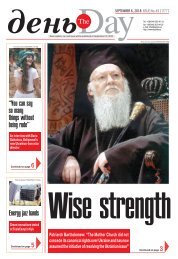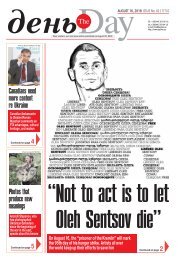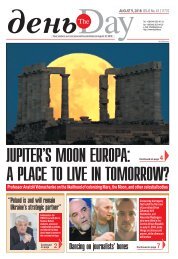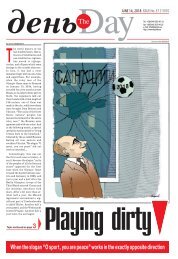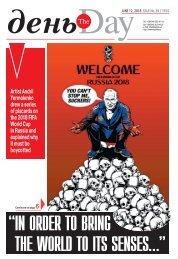#47_1-8
Create successful ePaper yourself
Turn your PDF publications into a flip-book with our unique Google optimized e-Paper software.
WWW.DAY.KIEV.UA<br />
CULT URE No.47 SEPTEMBER 20, 2018 7<br />
By Maria PROKOPENKO,<br />
photos by Mykola TYMCHENKO,<br />
The Day<br />
Fever on the streets and a pompous<br />
cold Empire style, new privileges<br />
for the third estate and the<br />
emergence of an empire which<br />
could rival the Roman one in<br />
grandeur, although it existed for a much<br />
shorter time… The history of France<br />
200 years ago has a lot of figures that can<br />
be easily found in today’s Ukraine. The<br />
proof of this is the exhibit “Freedom vs.<br />
Empire” now being held at the National<br />
Bohdan and Varvara Khanenko Museum<br />
of Arts. Many of the items are exhibited<br />
for the first time. The bulk of the exhibits<br />
are graphic pictures, but what attracts the<br />
greatest attention is caricature. The<br />
exposition also displays porcelain,<br />
Wedgwood plaques, and other historical<br />
items.<br />
● CONCEPT<br />
The project’s idea came up a few years<br />
ago. Oleksandra Isaikova, a senior research<br />
associate at the museum’s graphics<br />
section, who is, together with the section<br />
head Olena Shostak, the curator of<br />
this exhibit, calls it a cultural project,<br />
when various items show a profile of a certain<br />
era or phenomenon. Besides, Isaikova<br />
confesses, the deeper the museum got<br />
absorbed in the subject, the more it understood<br />
that this closely echoes with<br />
20th-century history and today. The story<br />
unfolds from the beginning of the 1789<br />
French Revolution until the exile of<br />
Napoleon to the island of Saint Helena,<br />
where he died.<br />
● A “STOP IMAGE”<br />
OF THE SEIZURE<br />
OF THE BASTILLE<br />
One of the first exhibited works is<br />
Jacques-Louis Bance’s etching “The<br />
Storming of the Bastille.” “This composition<br />
was unbelievably popular. It was repeated<br />
many times, and later artists painted<br />
pictures on the basis of this engraving.<br />
For there were no photo cameras at that<br />
time, and everything is fixed here,” Isaikova<br />
says.<br />
French King Louis XVI seems to be<br />
looking at this scene – for an engraving<br />
by Johann von Mueller, done on the basis<br />
of the monarch’s grand portrait,<br />
hangs on the opposite wall. The museum<br />
people are saying that, as long as this image<br />
of the king was of great ideological<br />
importance, the engraver was specially<br />
invited to Paris to do a drawing. The<br />
master worked on the engraving for<br />
four years, but the work lost its importance<br />
in 1789 because the country’s political<br />
life changed radically. The engraving<br />
was first released in 1793 in<br />
Nuremberg, when the king and his wife<br />
Marie Antoinette were executed.<br />
● REDISTRIBUTING<br />
OPPORTUNITIES<br />
HANDKERCHIEF “THE STAGE OF EUROPE IN DECEMBER 1812”<br />
“Caricature as a genre of art was finally<br />
formed in the 18th century. It is<br />
the French Revolution events that gave<br />
impetus to the development of French<br />
caricature in a situation of new freedoms<br />
and challenges,” Isaikova points out.<br />
The key theme of the cartoons drawn<br />
in 1789-91, at the beginning of the<br />
French Revolution, is the alliance of<br />
three estates – the clergy, the nobility,<br />
and commoners. “There were still illusions<br />
of being able to achieve equality<br />
and fraternity. This is why we can see a<br />
bit idyllic pictures here,” Isaikova adds.<br />
Here the three estates unite in a<br />
dance, and a good-natured caricature is<br />
accompanied with sentimental verses.<br />
And the next cartoon strikes a more<br />
threatening note: a third estate representative<br />
robs an embarrassed noble of<br />
his officer tunic, while a cleric looks on<br />
pensively. “Indeed, sir, I think your<br />
tunic of an officer will suit me better,”<br />
the caption says. This story dates back<br />
to the formation of the National Guard<br />
in Paris on July 14, 1789. The rank of an<br />
officer was usually a privilege of the nobility,<br />
but even a commoner could<br />
achieve a high rank in the National<br />
Guard, if he showed certain abilities and<br />
the leadership liked him. So this insti-<br />
The art of revolution<br />
tution became an important symbol of<br />
A new exhibit at the Khanenko Museum shows<br />
fighting for the third estate’s new opportunities.<br />
how people fought for freedom and ridiculed the empire<br />
PLATE. THE MANUFACTURE NATIONALE DE SEVRES, 1846<br />
THE ULTIMATE IN CANNIBALISM, 1815<br />
● A CANNIBAL ON THE RIVERS<br />
OF BLOOD<br />
Among the displayed caricatures of<br />
the times of Napoleon’s First Empire, the<br />
rarest are those created by royalists. Often<br />
anonymous, they were published in<br />
England, where Napoleon was not liked,<br />
and then smuggled to and distributed in<br />
France in order to undermine the emperor’s<br />
prestige.<br />
“These sheets are from the album that<br />
belonged to Count Henryk Ilinski who had<br />
a manor near Zhytomyr,” Isaikova notes.<br />
“How they found themselves in our museum<br />
is a mystery. Anyway, there is seal<br />
on each sheet with the inscription ‘Count<br />
Henryk Ilinski’ and his personal coat of<br />
arms.”<br />
“The Ultimate in Cannibalism,” a<br />
caricature created in 1815 by Louis Francois<br />
Charon, parodies Napoleon’s fulldress<br />
portrait by the artist Jean August<br />
Dominique Ingres. “The full-dress portrait<br />
depicts Napoleon on the throne in a<br />
mantle and with a scepter. On the caricature,<br />
he also wears a mantle but is<br />
seated on a pile of dead soldiers and, besides,<br />
on the bank of a ‘river of blood,’ as<br />
the caption says. We can see cities reduced<br />
to dust and the attacking troops. My<br />
most favorite detail is a tricolor that<br />
shows the Phrygian cap, a symbol of<br />
freedom, surrounded by chains, while the<br />
caption says: ‘Disguised as freedom, I’ve<br />
chained you,’” Isaikova comments.<br />
Even if royalist masters did not sign,<br />
they could be easily recognized by style and<br />
content. Firstly, a right composition with<br />
a good drawing was typical of such works.<br />
A commoner could have hardly created<br />
this, while aristocratic education included<br />
art exercises. Another particularity is<br />
a huge number of captions in small print.<br />
According to Isaikova, the best examples<br />
of folk caricature comprise fewer inscriptions,<br />
for they should be understood by<br />
large masses of the illiterate populace.<br />
Thirdly, accusations against Napoleon of,<br />
say, crushing a royalist revolt usually<br />
found an echo in the old aristocracy only.<br />
● A DANCE AROUND<br />
THE TREE OF FREEDOM<br />
“Soldiers of the French Revolutionary<br />
Army Are Erecting a Tree of Liberty<br />
in Zweibruecken on February 11, 1793” –<br />
the Ukrainian spectator will easily recognize<br />
the prototype of Kyiv’s notorious<br />
Christmas tree in this caricature by Jean<br />
Godefroy.<br />
The engraving was found this year in<br />
the museum’s repository. It depicts the<br />
French troops that are putting up a Tree of<br />
Liberty, a symbol of the French Revolution.<br />
This symbol came from the US and later<br />
spread all over the world. “The French revolutionary<br />
troops were in the habit of<br />
erecting a Tree of Liberty at every place<br />
they were coming to,” Isaikova says. “The<br />
tree on the engraving really looks like a<br />
Christmas tree, but it was usually an oak<br />
or any other tree. Sometimes it was just a<br />
stick adorned with ribbons. A Phrygian cap<br />
was put on the Liberty Tree’s top, and a celebration<br />
in honor of freedom and equality<br />
was held. It usually consisted of dances,<br />
such as carmagnole or farandole.”<br />
● GREAT VICTORIES AND<br />
DEFEATS<br />
In the hall about the First Empire, you<br />
can see engravings that depict victories of<br />
Napoleon’s army, for example the outcome<br />
of the Battle of Austerlitz. Jean Godefroy<br />
made this engraving after Francois Gerard’s<br />
picture commissioned by Napoleon on<br />
the second day after his victory. The emperor<br />
could not help being proud of this<br />
event, for the enemy considerably outnumbered<br />
his army. As a result, the anti-<br />
French coalition broke up.<br />
The picture portrays Napoleon himself<br />
on a white horse the moment General<br />
Rapp arrives to announce the victory. In<br />
general, there are a lot of historical persons<br />
among the characters. Isaikova points at<br />
marshals Berthier and Bessieres, generals<br />
Duroc and Junot, and the captured Russian<br />
Prince Repnin-Volkonsky.<br />
Next to the image of a great victory is<br />
the print “The Death of Prince Jozef Poniatowski<br />
during the Crossing of the Elster<br />
on October 19, 1813” by Philibert Louis Debucourt,<br />
which shows the defeat of<br />
Napoleon’s troops in the Battle of Leipzig,<br />
after which the emperor abdicated the<br />
throne. The national hero of Poland, Jozef<br />
Poniatowski, died covering the French<br />
army’s retreat.<br />
● HEALTH-FRIENDLY EMPIRE<br />
STYLE<br />
These battle scenes are in contrast<br />
with empire-style household stuffs, such as<br />
porcelain items by French and German<br />
manufacturers, a dainty clock, and plaques.<br />
Some of them, incidentally, bear the portraits<br />
of Napoleon’s enemies: British Prime<br />
Minister William Pitt, Admiral Nelson, and<br />
Admiral Hood. Isaikova notes that the key<br />
sign of the empire style is reference to classical<br />
antiquity and military subjects. Even<br />
those who resisted Napoleon liked this<br />
style which flourished in the emperor’s<br />
hour of triumph.<br />
Refined vessels contrast with rather a<br />
simple desk of the architect made in the<br />
first half of the 18th century. It is a representative<br />
of the then popular folding furniture<br />
called “a la Tronchin” – after physician<br />
Theodore Tronchin who invented it.<br />
“In particular, Tronchin healed spinal<br />
disorders architects complained about.<br />
This doctor understood that architects<br />
just sit uncomfortably at work and invented<br />
a desk at which one can work well<br />
without harming his back. The desk’s<br />
height can be adjusted by means of special<br />
legs. The angle of the desk top’s can also<br />
vary if necessary,” Isaikova says.<br />
● DEATH, CRUTCHES,<br />
AND A WHITE CAT<br />
After the Leipzig defeat, Napoleon abdicated<br />
the throne and was exiled to the island<br />
of Elba. France saw the beginning of<br />
a short period of Restoration, when the<br />
Bourbons regained power. Closely watching<br />
the developments, Napoleon chose a favorable<br />
moment, landed in France with just<br />
a thousand of soldiers, and reaches Paris<br />
in two weeks. This signaled the so-called<br />
Hundred Days period, when Napoleon<br />
managed to stay in power again.<br />
The caricature “The Arrival of Nicolas<br />
Buonaparte at Tuileries on March 20,<br />
1815” shows this moment. The emperor is<br />
accompanied by the figures of Death and<br />
Poverty, and crutches are falling out of the<br />
box on which it is written “War Compensations.”<br />
It is clear from the gloomy faces<br />
of commoners and bourgeois that these people<br />
do not believe Napoleon’s promises. The<br />
most good-natured character here is a<br />
well-fed white cat in the center who says:<br />
“I have velvet paws.” This French idiom describes<br />
a person who pretends to be kind but<br />
has a selfish motive.<br />
Read more on our website





